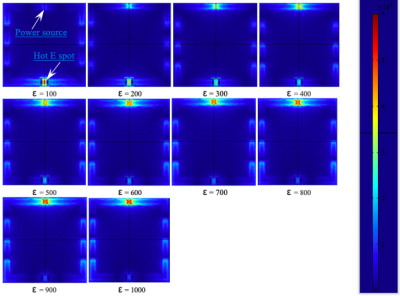1404
High dielectric sheet to reduce electric fields in Self-decoupled radiofrequency coils for magnetic resonance imaging1Biomedical Engineering, State University of New York, Buffalo, Buffalo, NY, United States
Synopsis
Self-decoupled radiofrequency coils reduce the electromagnetic coupling between the coil elements and eliminate the use of complex decoupling technologies. The use of a small value capacitor (Cmode) in a self-decoupled coil helps in eliminating the coupling between coil elements but causes a large electric field across the Cmode capacitor1.which may potentially cause a safety problem during imaging. In this study, we propose the use of a high dielectric sheet to reduce the electric field across the capacitor and thereby reducing the higher SAR in the subject.
Introduction
Magnetic resonance imaging (MRI) is a widely used non-invasive medical imaging modality that provides a variety of high-resolution images of the human body, with versatile soft-tissue and functional contrast2. The conventional radiofrequency coil used in MR imaging gives rise to coupling when combined with other coil elements to form an array. Advances in MRI have come through increasing the number of coils in the array for better performance in imaging acceleration and/or sensitivity. Coupling between the conventional coil elements demands the use of complex decoupling technologies, but these technologies are difficult to employ and may require to manipulate the shape of the loop structure and degrade the coil sensitivity because of the extra electronic components involved. To avoid the use of complex decoupling technologies and retain the shape of the loop structure, self-decoupled coils can be used. However, the self-decoupled coils have supplied a major issue in regards to high electric fields across the Cmode capacitor which may produce high SAR in the subject, increasing the temperature produced by coil1. For this particular issue, the researchers have suggested breaking up the Cmode capacitor into a capacitance-equivalent set of larger series capacitors3,4. In this study, we propose an alternative to reduce the electric fields across the Cmode capacitor while keeping the Cmode capacitor intact.Method
We designed a 10×10 cm2 self-decoupled surface coil and placed a 1 mm thick sheet of high dielectric material just above the Cmode capacitor. The dielectric constant of the sheet was varied from 100 to 1000. The self-decoupled coil was tuned to 300 MHz to compute the frequency response and the Electric fields & B1 fields produced by the coil were observed by plotting 3D slice plots. The input power was 1 watt. We used 6 equally distributed capacitors (8pF) with one Cmode capacitor (0.44 pF). We assigned the copper material to the coil element and the dielectric sheet’s material properties were set as; relative permeability = 1, electrical conductivity: 0. The phase angle of the feed line was set to 00. We performed two simulations to compare both cases: one with the dielectric sheet present above the Cmode capacitor and the other situation where the dielectric sheet is not placed above the capacitor. The performance of the proposed alternative to reduce the electric field across the Cmode capacitor was evaluated by Electric & B1 field distribution in electromagnetic simulations.Result
The B1 & Electric field distributions are obtained as shown in Fig.2,3. For comparison, we have also evaluated the electric and B1+ fields at the surface of the coil when the dielectric sheet is not placed on the Cmode capacitor. The changes in the electric field strength are shown in Table 1. The electric fields were reduced from 6.99×103 V/m to 1.2×103 V/m with a higher dielectric constant. Also, our results show that the use of a higher dielectric constant enhances the B1 field produced by the coil.Discussion/Conclusion
A new alternative to the major issue produced in self-decoupled RF coil was proposed. The electric & B1 fields were evaluated by the simulation, which demonstrates the considerable reduction in electric fields across the Cmode capacitor. This approach showed positive effects on the B1 fields as the increase in B1 field strength was observed with the higher dielectric sheet.Acknowledgements
No acknowledgement found.References
References
1. Yan X, Gore JC, Grissom WA: Self-decoupled radiofrequency coils for magnetic resonance imaging. Nature Communications 2018, 9(1):3481.
2. Lauterbur, P. C. Image formation by induced local interactions. Examples employing nuclear magnetic resonance. Nature 242, 190–191 (1973).
3. Lakshmanan, K., Cloos, M. A., Lattanzi, R., Sodickson, D. K. & Wiggins, G. C. in International Society for Magnetic Resonance in Medicine 397 (Milan, 2014).
4. Ha, S., Zhu, H. & Petropoulos, L. in International Society of Magnetic Resonance in Medicine 3117 (Toronto, 2015).
Figures




